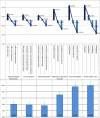Patient Preferences for Features of Health Care Delivery Systems: A Discrete Choice Experiment
- PMID: 26255998
- PMCID: PMC4799904
- DOI: 10.1111/1475-6773.12345
Patient Preferences for Features of Health Care Delivery Systems: A Discrete Choice Experiment
Abstract
Objective: To estimate the relative importance of organizational-, procedural-, and interpersonal-level features of health care delivery systems from the patient perspective.
Data sources/study setting: We designed four discrete choice experiments (DCEs) to measure patient preferences for 21 health system attributes. Participants were recruited through the online patient portal of a large health system. We analyzed the DCE data using random effects logit models.
Data collection/extraction methods: DCEs were performed in which respondents were provided with descriptions of alternative scenarios and asked to indicate which scenario they prefer. Respondents were randomly assigned to one of the three possible health scenarios (current health, new lung cancer diagnosis, or diabetes) and asked to complete 15 choice tasks. Each choice task included an annual out-of-pocket cost attribute.
Principal findings: A total of 3,900 respondents completed the survey. The out-of-pocket cost attribute was considered the most important across the four different DCEs. Following the cost attribute, trust and respect, multidisciplinary care, and shared decision making were judged as most important. The relative importance of out-of-pocket cost was consistently lower in the hypothetical context of a new lung cancer diagnosis compared with diabetes or the patient's current health.
Conclusions: This study demonstrates the complexity of patient decision making processes regarding features of health care delivery systems. Our findings suggest the importance of these features may change as a function of an individual's medical conditions.
Keywords: Patient preference; choice behavior; delivery of health care; discrete choice models.
© Health Research and Educational Trust.
Figures
Similar articles
-
Task Shifting, eHealth and Shared Decision-Making-Preference Heterogeneity in the Adult Population for Developments in Outpatient Primary Healthcare.Health Expect. 2025 Feb;28(1):e70060. doi: 10.1111/hex.70060. Health Expect. 2025. PMID: 39907194 Free PMC article.
-
Comparing Discrete Choice Experiment with Swing Weighting to Estimate Attribute Relative Importance: A Case Study in Lung Cancer Patient Preferences.Med Decis Making. 2024 Feb;44(2):203-216. doi: 10.1177/0272989X231222421. Epub 2024 Jan 4. Med Decis Making. 2024. PMID: 38178591 Free PMC article.
-
Survival or Mortality: Does Risk Attribute Framing Influence Decision-Making Behavior in a Discrete Choice Experiment?Value Health. 2016 Mar-Apr;19(2):202-9. doi: 10.1016/j.jval.2015.11.004. Epub 2016 Jan 7. Value Health. 2016. PMID: 27021754
-
Patients' preferences for the treatment of anxiety and depressive disorders: a systematic review of discrete choice experiments.J Med Econ. 2020 Jun;23(6):546-556. doi: 10.1080/13696998.2020.1725022. Epub 2020 Feb 24. J Med Econ. 2020. PMID: 32011209
-
Dyadic Discrete Choice Experiments Enable Persons with Dementia and Informal Caregivers to Participate in Health Care Decision Making: A Mixed Methods Study.J Alzheimers Dis. 2023;91(1):105-114. doi: 10.3233/JAD-220604. J Alzheimers Dis. 2023. PMID: 36373319 Free PMC article.
Cited by
-
Discrete Choice Experiments in Health Economics: Past, Present and Future.Pharmacoeconomics. 2019 Feb;37(2):201-226. doi: 10.1007/s40273-018-0734-2. Pharmacoeconomics. 2019. PMID: 30392040 Free PMC article.
-
Comparison of Preferences and Data Quality between Discrete Choice Experiments Conducted in Online and Face-to-Face Respondents.Med Decis Making. 2023 Aug;43(6):667-679. doi: 10.1177/0272989X231171912. Epub 2023 May 18. Med Decis Making. 2023. PMID: 37199407 Free PMC article.
-
Does the Public Prefer Health Gain for Cancer Patients? A Systematic Review of Public Views on Cancer and its Characteristics.Pharmacoeconomics. 2017 Aug;35(8):793-804. doi: 10.1007/s40273-017-0511-7. Pharmacoeconomics. 2017. PMID: 28455834 Free PMC article.
-
Patient preferences for diagnostic imaging services: Decentralize or not?PLoS One. 2025 May 16;20(5):e0301404. doi: 10.1371/journal.pone.0301404. eCollection 2025. PLoS One. 2025. PMID: 40378352 Free PMC article.
-
Effects of Virtual Care on Patient and Provider Experience of the Clinical Encounter: Qualitative Hermeneutic Study.J Med Internet Res. 2024 Nov 26;26:e52552. doi: 10.2196/52552. J Med Internet Res. 2024. PMID: 39591608 Free PMC article.
References
-
- Amelung, V. E. 2012. Managed Care: Neue Wege im Gesundheitsmanagement. Berlin: Springer.
-
- Bech, M. , and Gyrd‐Hansen D.. 2005. “Effects Coding in Discrete Choice Experiments.” Health Economics 14 (10): 1079–83. - PubMed
-
- Becker, K. , and Zweifel P.. 2008. Age and Choice in Health Insurance: Evidence from Switzerland. Zürich: Sozialökonomisches Institut, University of Zürich.
-
- de Bekker Grob, E. W. , Ryan M., and Gerard K.. 2010. “Discrete Choice Experiments in Health Economics: A Review of the Literature.” Health Economics 21 (2): 145–72. - PubMed
-
- Berwick, D. M. 2011. “Launching Accountable Care Organizations—The Proposed Rule for the Medicare Shared Savings Program.” New England Journal of Medicine 364 (16): e32. - PubMed
Publication types
MeSH terms
LinkOut - more resources
Full Text Sources
Other Literature Sources
Medical
Molecular Biology Databases





